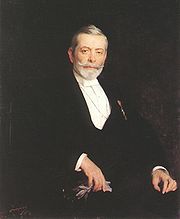
Ignaz Wechselmann
Encyclopedia

Hungary
Hungary , officially the Republic of Hungary , is a landlocked country in Central Europe. It is situated in the Carpathian Basin and is bordered by Slovakia to the north, Ukraine and Romania to the east, Serbia and Croatia to the south, Slovenia to the southwest and Austria to the west. The...
architect
Architect
An architect is a person trained in the planning, design and oversight of the construction of buildings. To practice architecture means to offer or render services in connection with the design and construction of a building, or group of buildings and the space within the site surrounding the...
and philanthropist
Philanthropist
A philanthropist is someone who engages in philanthropy; that is, someone who donates his or her time, money, and/or reputation to charitable causes...
.
Educated in Berlin
Berlin
Berlin is the capital city of Germany and is one of the 16 states of Germany. With a population of 3.45 million people, Berlin is Germany's largest city. It is the second most populous city proper and the seventh most populous urban area in the European Union...
, Wechselmann moved to Vienna
Vienna
Vienna is the capital and largest city of the Republic of Austria and one of the nine states of Austria. Vienna is Austria's primary city, with a population of about 1.723 million , and is by far the largest city in Austria, as well as its cultural, economic, and political centre...
where he became the friend and assistant of the architect Ludwig Förster
Ludwig Förster
Ludwig Christian Friedrich Förster was a German-born Austrian architect.Ludwig Förster studied in Munich and Vienna. He founded the Allgemeine Bauzeitung in 1836...
. In 1856 he moved to Budapest, where he, as Förster's representative, superintended the building of the Dohány Street Synagogue
Dohány Street Synagogue
The Great Synagogue, also known as Dohány Street Synagogue or Tabakgasse Synagogue, is located in Erzsébetváros, the 7th district of Budapest. It is the third largest synagogue in Eurasia and the fifth largest in the world...
. Most of the monumental buildings erected in the Hungarian capital between 1870 and 1890 were designed by him, his work including palaces, mills, factories, churches, and the famous Burg-Bazar. In 1886 he received the Order of the Iron Crown
Order of the Iron Crown
The Imperial Order of the Iron Crown was established June 5, 1805 by Napoleon Bonaparte . It took its name from the ancient Iron Crown of Lombardy, a medieval jewel with an iron ring, forged from what was supposed to be a nail from the True Cross as a band on the inside. This crown also gave its...
of the third class, and shortly afterward Francis Joseph I.
Franz Joseph I of Austria
Franz Joseph I or Francis Joseph I was Emperor of Austria, King of Bohemia, King of Croatia, Apostolic King of Hungary, King of Galicia and Lodomeria and Grand Duke of Cracow from 1848 until his death in 1916.In the December of 1848, Emperor Ferdinand I of Austria abdicated the throne as part of...
elevated him to the Hungarian nobility.
Failing eyesight compelled Wechselmann to retire from active life in 1890, whereupon he devoted his time to philanthropic activity in Budapest. His greatest act of charity was embodied in two clauses in his will, by which he bequeathed one million kronen to the Institute for the Blind, and two millions for the support of meritorious teachers in the public schools. Half of these beneficiaries were to be Jews and the other half Christians; and the board of directors of the Jewish community was entrusted with the administration of the bequests.

